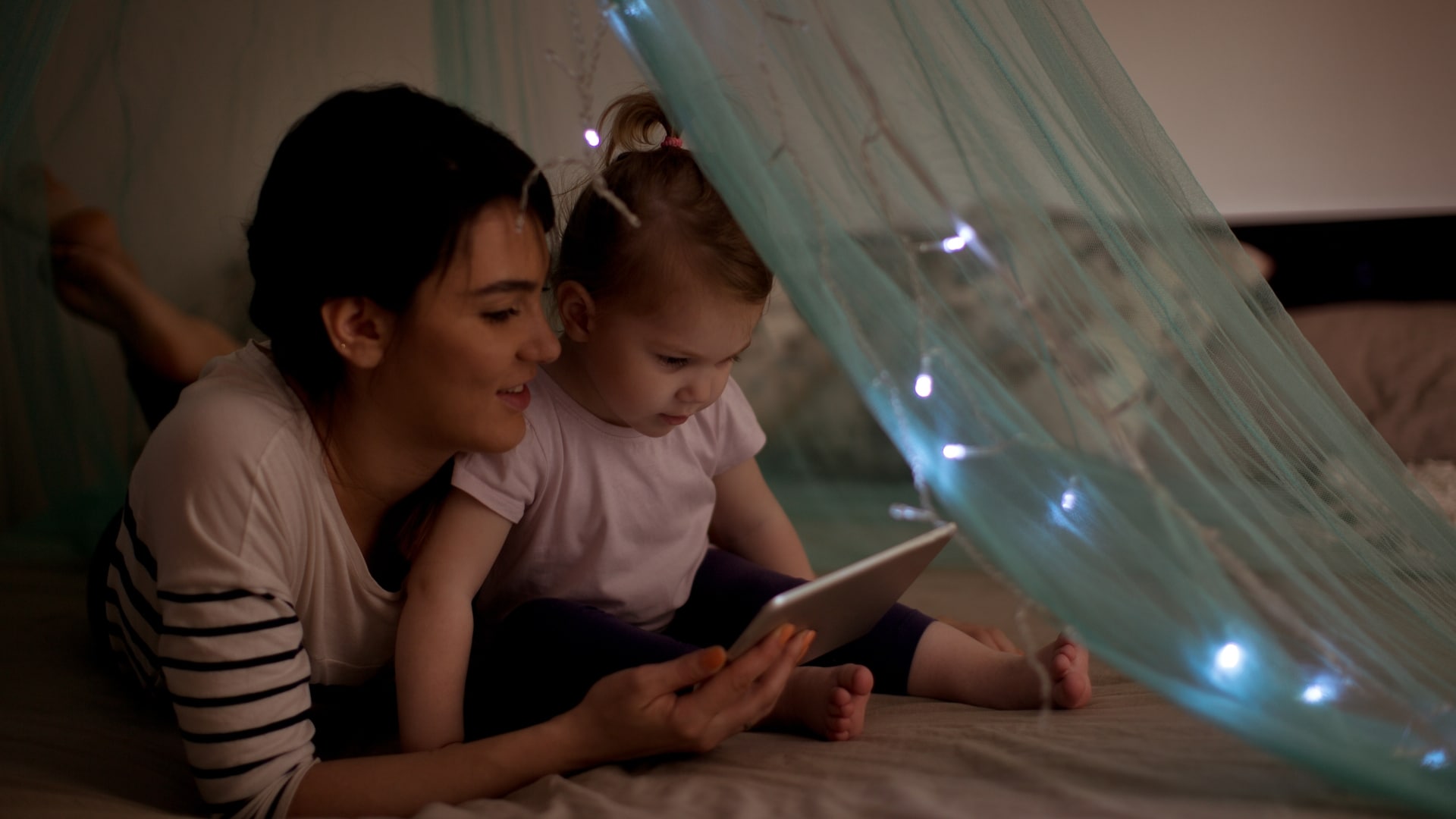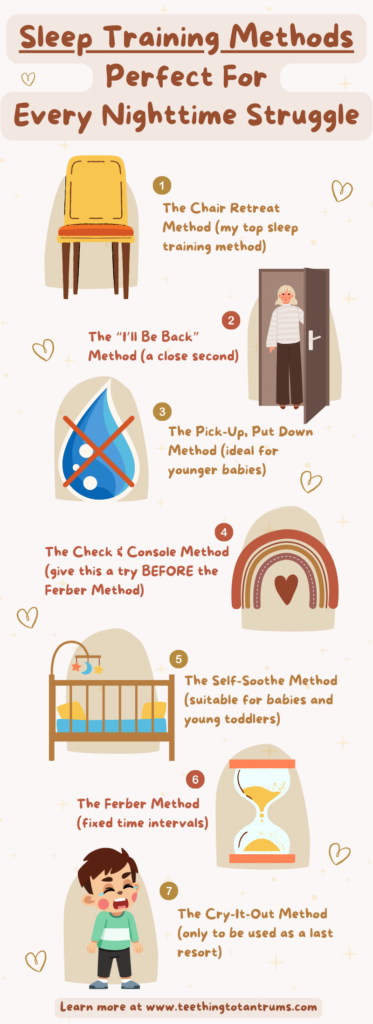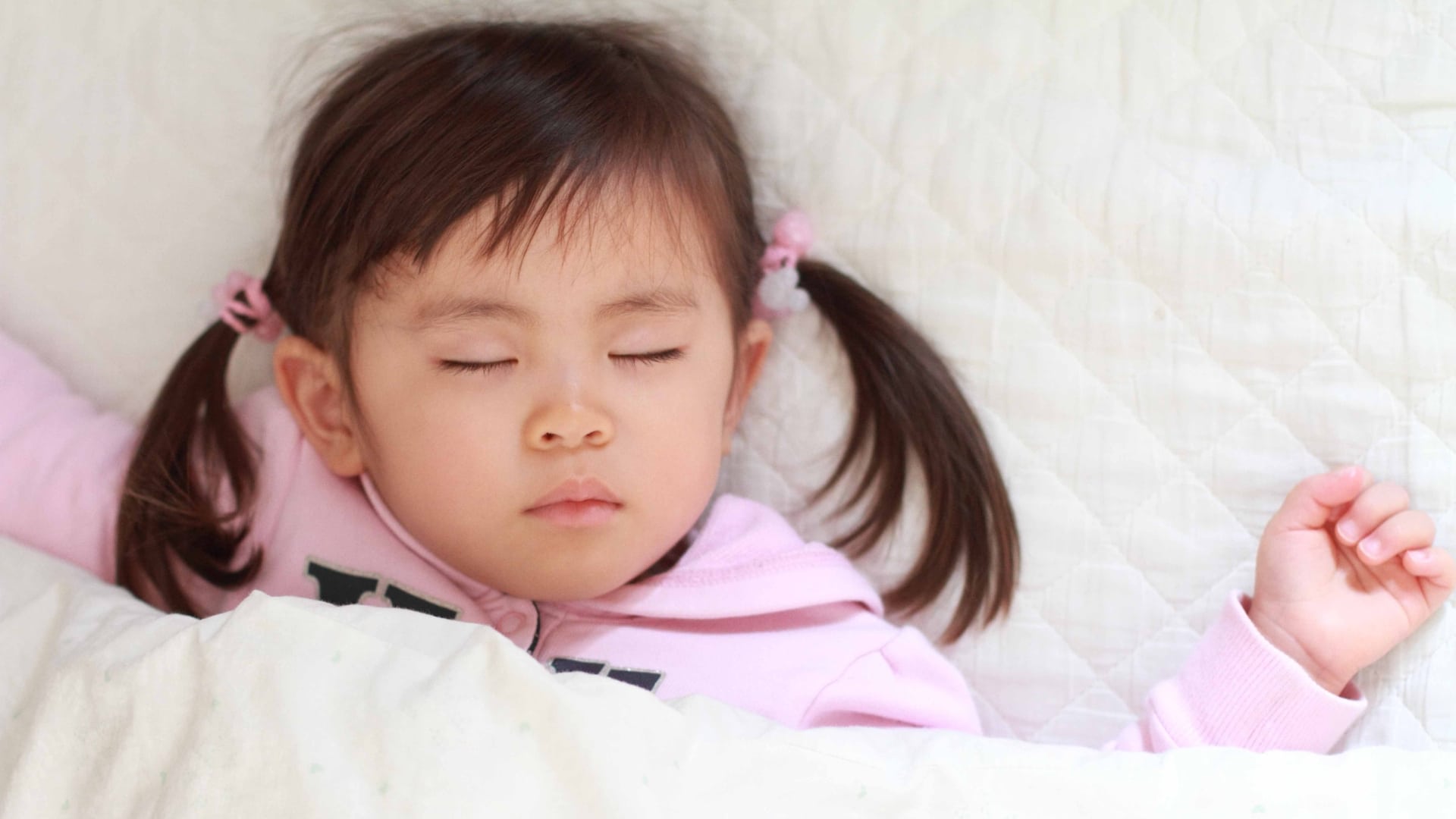Sleep training is a fine art. One that must be refined to you and your child’s preferences. But how do you know what will work? What do you do if your child’s sleep habits are making you feel completely overwhelmed?
You research sleep training methods.
Which 9 times out of 10, leaves you feeling even more overwhelmed.
So I’m here to help clear up a few misconceptions about sleep training and provide you with over 40 years of sleep training experience as a Norland Nanny condensed into 1 article so you leave feeling confident and ready to tackle any sleep struggles you are currently facing.
Ready to get started? Let’s dive right in.

Table of Contents
What Is Sleep Training?
Sleep training is when you teach your little one to fall asleep independently and sleep through the night. It involves developing healthy sleep habits and breaking negative sleep associations. This is done by gradually teaching your child to fall asleep without external soothing, such as contact napping, being rocked, or being fed to sleep.
7 Steps To Take When Preparing For Sleep Training
In my many years of experience, I have discovered that no matter what sleep training method you eventually decide to use… you will need to have a few core sleep habits in place.
These are my go-to gentle sleep training techniques that can (more often than not) successfully teach your little one to fall asleep independently and self-soothe WITHOUT the need for more rigid sleep training methods.
- Consider the age of your baby. The American Academy of Pediatrics recommends that the ideal age to start sleep training is between 4 and 6 months old. This is because your baby’s brain and body are developmentally ready to learn how to self-soothe and be physically able to nap more consistently throughout the day. It is also around the time when your baby may start to sleep through the night (except for night feeds). If your little one is 4 months or younger, I would recommend that you wait before starting to work on any form of sleep training. Starting too early will more than likely end in frustration. Equally, sleep training when baby is slightly older can have benefits too. There is no right or wrong way to sleep train… Just make sure your baby is older than 4 months as a minimum.
- Knowledge is your greatest ally in sleep training so start by knowing how much age-appropriate sleep your little one needs in a 24-hour period. To find out what that is, read this article. Too much sleep and your child won’t want to go to bed. Too little sleep and your overtired adrenaline-filled child will not want to settle either. It’s a delicate balance.
- Creating consistency around bedtime and nap times will help set your child’s internal circadian rhythm adjusting their sleep patterns to sync up with their natural sleep cycle. Two of the best ways to do this are to 1) get outside every day in the fresh air and natural daylight to balance your child’s melatonin levels and 2) have bedtime at the same time every day, even on weekends.
- Observe your little one’s sleep cues, so you can better predict the ideal times for sleep. You can also keep track of your child’s wake windows. Learn more about those here: Wake Windows By Age: Optimal Sleep For Babies And Children
- Encourage your little one to fall asleep alone by putting them down while drowsy and not fast asleep. You can also encourage your baby to spend short amounts of alone time in their crib during the day to help with self-settling. Or encourage your toddler to have some quiet time after lunch to reset for the afternoon.
- Gradually wean your child off sleep associations that hinder self-soothing such as feeding or rocking to sleep. To help your child wean off a bedtime bottle, read these posts: How To Get Baby To Sleep Without A Bottle In Under 7 Days and How To Get A Toddler To Sleep Without A Bottle Instantly!
- Ensure the environment in your child’s room promotes sleep. Consider using a nightlight or white noise machine to provide comfort and to help the room feel cozy. Soft sheets and comfortable sleepwear will also help your little one feel relaxed and snuggly.
NOTE: Putting your baby in their crib while awake with no pressure to sleep for short periods can help them learn to be happy with being alone and ease bedtime separation anxiety. With older children, encourage them to play independently during the day and to spend some time away from you with alternative carers.
7 Sleep Training Methods Every Parent Needs To Know
Before we begin… I need to clarify one thing.
In my opinion, sleep training is not about letting your baby cry it out; it’s about finding ways to support your child as they learn to self-soothe and fall asleep independently.
Therefore, you must be well informed on what sleep training methods are on offer to help you and your child get the most out of the training. Here’s a quick video that explains the Pros and Cons of popular baby sleep training methods:
You (and any other caregivers) must also be consistent in your approach to assist in developing healthy sleep habits in your child.
Sleep training is not a quick fix.
It is a process that will teach your little one a vital life skill.
And as every child’s sleep needs and patterns are unique, it might take some time for sleep training to show results.
Rest assured this is normal and if you implement these sleep training methods, you will have a peaceful sleeper in no time:

1. The Chair Method
The Chair Method is one of my top sleep training methods for children of all ages.
The technique involves gradually reducing your presence in your child’s room by sitting near their bed on a chair or the floor until they fall asleep.
The aim is that over successive nights you can increase the distance between you and your little one until they feel comfortable falling asleep without your presence in the room.
Start by putting your child to sleep whilst they’re drowsy but not fast asleep. If needed, you can hold their hand or stroke their tummy to let them know you’re there.
Over a few nights, progress to no touching. You can offer words of comfort but keep conversation to a minimum.
Next, reduce the words of comfort and very gradually move further away from the bed.
This gentle approach to sleep training lessens separation anxiety and helps your child learn to fall asleep independently without you touching or lying next to them. This method can offer comfort and security to your child, strengthening their ability to fall asleep alone.
The ideal age range to use this sleep training method: 9 months and up.
2. The “I’ll Be Back” Method
The “I’ll Be Back” technique is another of my preferred sleep training methods, but one I’d reserve for older toddlers and preschoolers.
Also known as Promised Return, “I’ll Be Back” involves settling your little one into bed as usual, saying good night, and then telling them that you have to go and do something but you will be back in a few minutes.
The key is to make whatever you are ‘doing’ as boring as possible to your child (laundry, emails, and cleaning are all good options) and that you return as promised.
Repeat this process, gradually extending the time you are away until your little one is asleep on one of your returns.
Follow this pattern every night until your little one is asleep on your first return and voila! Your child has learned to fall asleep independently.
(PS: you don’t have to go and do emails… it’s simply to stop your toddler from wanting to join in)
The ideal age range to use this sleep training method: 18 months and up.
3. The Pick-Up, Put Down Method
Also known as the “No Tears” approach, the Pick-Up, Put-Down sleep training method also involves putting your baby down when drowsy but not fast asleep… but unlike the Chair Method, you leave them for a short while, and if your baby fusses, you pick your baby up until they are calm then put them down again.
You repeat this method until your baby manages to fall asleep without being held.
With this method, you are present to provide comfort but allow your baby the chance to settle down on their own. This reinforces the ability to self-soothe while minimizing stress and tears.
Bear in mind that as this is a gentle sleep training method, it will be less stressful for you and your baby, but it can take longer to achieve results.
The ideal age range to use this sleep training method: 5 months to 12 months
4. The Check and Console Method
The Check and Console Method of sleep training is a gentler version of the Ferber Method and is more suitable for older babies.
For this method, you put your child down when drowsy but not asleep, say good night, and leave for a set time period.
Usually, 1 minute, followed by 2 minutes, followed by 3 minutes, followed by 4 minutes, and so on.
You then return to check on your child, ideally before they are crying.
If they are upset, you should not pick them up, instead, you can pat their tummy, sing a lullaby, or gently stroke their forehead to settle them back down.
Once baby is settled, leave again for the next period.
Over several nights, you can gradually increase the time you leave your baby alone until they are content by themselves and asleep when you return.
The ideal age range to use this sleep training method: 9 months to 18 months
NOTE: Some babies will become excited when their parents keep checking in and will struggle to settle. If this is the case, you may need to look at trying an alternative sleep training method.
5. The Self-Soothe Method
The Self-Soothe Sleep Method is a more subtle sleep training style and the one I would recommend parents of younger babies should try if the Check and Console Method has not worked.
It involves helping your baby to fall asleep on their own without any assistance from you by putting into place a routine that gives them the best possible chance to fall asleep independently.
This means weaning off contact napping, having a consistent nap and bedtime routine, putting your baby down when they are drowsy and not fast asleep, and gradually reducing the amount of time you spend with your baby settling them.
It also involves making baby’s sleep environment dimly lit and cozy by using a white noise machine, a sleep app, a pacifier, or having a favorite cuddly toy as company.
(Essentially all the sleep habit tips I outlined at the beginning of this post)
The ideal age range to use this sleep training method: 6 months to 18 months
White noise machines are a game-changer for your little one's sleep and having one that plays all night is a must. With a long-lasting battery, this compact and stylish white noise machine contains 21 non-stop relaxing noises, which will lull your little one to sleep night after night, no matter where you are!
6. The Ferber Method
The Ferber Method is a sleep training technique developed by pediatrician and sleep expert Dr Richard Ferber that teaches babies to self-soothe and fall asleep on their own.
It involves increasing the amount of time a baby is left alone to cry by set amounts before being comforted.
Check-ins are done in timed intervals, starting with a short period of crying and gradually increasing the time.
For example, 3 minutes of crying, visit, resettle. Then 5 minutes of crying, visit, resettle. Then 10 minutes of crying, visit, resettle, and so on.
The Ferber Method relies on consistent behavior and cues from the parent. Therefore, it is important to follow a consistent bedtime routine and to respond to the baby’s cries in the same way each time. This helps baby learn what to expect and feel secure.
The Ferber method involves an element of letting your little one cry and so it is not a sleep training method that I advocate for very young children unless it’s a last resort.
I believe the Ferber method can work well for a persistent toddler or preschooler.
However, many parents have had success with this method on younger children and I wouldn’t be doing my job properly if I didn’t give you all the pros and cons of a sleep training method.
The ideal age range to use this sleep training method: 9 months to 2.5 years (but can be used from 6 months as a last resort)
7. The Cry It Out Method
Also known as the extinction method, the Cry-It-Out (CIO) Method is a stricter sleep training approach where you say goodnight and leave your child to fall asleep without returning.
The Cry It Out method is a controversial sleep training technique, with some experts saying it can help babies learn to self-soothe and fall asleep on their own…
And others warn of its potential to cause long-term emotional damage and undermine the parent-child bond.
It can be very hard for parents to implement due to excessive crying, but for those with a tough resolve, it can produce remarkable results.
Where Do I Stand?
Personally, I am not a fan of the Cry It Out sleep training method and would never use it for young babies.
However, for older toddlers or preschoolers who are having great difficulty learning to fall asleep alone…
The Cry It Out method can be the last resort once all the other healthy habit builders and sleep training methods have been tried.
And I would not be doing my job if I didn’t provide you with all the options for sleep training.
The ideal age range to use this sleep training method: 6 months and up but only as a last resort when all the other sleep training methods have been tried.
Which Sleep Training Method Is Best?
There is no best sleep training method. Each sleep training method requires patience and consistency to yield results.
The gentler sleep training methods often take longer to yield results and can be more tiring for parents… however, the Cry It Out or Ferber methods that involve leaving your child to cry can be very hard for parents to see through meaning their success is fracious.
Additionally, while guidance from reliable sources is valuable, what works best often depends on your baby’s temperament and your family’s individual needs.
My mantra when it comes to sleep training is: If it doesn’t feel right, don’t do it.
Looking to get your little one to sleep quickly and effortlessly? Check out my Bedtime and Nap Cheat Sheet and master the art of making daytime naps and bedtimes as seamless as possible.
A bedtime & nap cheat sheet so good your little one will ask you to put them to bed...
Laura Williams "This is a life saver! I'm so glad I downloaded your bedtime & nap cheat sheet. My little one actually asked me to put him to bed last night! Unbelievable! Thank you so much!"
Click Here For The FREE Cheat Sheet
Choosing The Right Sleep Training Method For You
When the time comes to teach your little one to sleep through the night, choosing the right method is very important.
Be mindful that every family is unique, what works for one might not work for another.
It’s also important to match the sleep training method to your family’s needs, considering your baby’s temperament and your parenting style.
As already stated consistency and patience are vital, no matter which strategy you choose.
Gentle sleep training approaches, like the Chair Method and the I’ll Be Back Method, are often favored for their softer transition toward independent sleep and are definitely what I would recommend for a baby or younger toddler.
Conversely, other methods may encourage infants to find self-soothing techniques on their own.
This can lead to some fussing… but in many cases, this can establish lasting sleep habits without your little one becoming overly distressed.
- I would likely recommend the Pick Up, Put Down Method for a 4-month-old,
- The Chair Method for an 18-month-old,
- But the I’ll Be Back Method for a 2 or 3-year-old.
Remember that sleep training is not just about your child—it’s also about adjusting to the rhythms of parenthood.
Having reasonable expectations of what your little one can achieve at any given age is crucial.
Babies under 6 months of age, for example, will wake at night for a feed or just for comfort and this is perfectly normal.
Helping them give up nighttime feeding and learning to resettle on their own can be a long process and you will need lots of patience to help your little one through these normal phases in their development.
Be ready to adapt and find what fits.

Which Sleep Training Method Is The Most Effective?
Determining the most effective sleep training method will vary by the age and temperament of your child.
However, from over 40 years of childcare experience, here is my guide to the sleep training methods I feel are most appropriate by age.
| Age | Most Effective Sleep Training Method |
| 0-3 months | No need for sleep training yet |
| 4 months | Gentle Sleep Training Methods |
| 5 months | Gentle Sleep Training Methods / Pick Up Put Down Method |
| 6 months | Gentle Sleep Training Methods / Pick Up Put Down Method / Self Soothe Method/Ferber Method |
| 7 months | Gentle Sleep Training Methods / Pick Up Put Down Method / Self Soothe Method/Ferber Method |
| 8 months | Gentle Sleep Training Methods / Pick Up Put Down Method / Self Soothe Method/Ferber Method |
| 9 months | Chair Method / Check and Console |
| 10 months | Chair Method / Check and Console |
| 11 months | Chair Method / Check and Console |
| 12 months | Chair Method / Check and Console |
| 18 months | Chair Method / I’ll Be Back |
| 2 years | Chair Method / I’ll Be Back |
| 3 years | Chair Method / I’ll Be Back |
| 4 years | Chair Method / I’ll Be Back / Set Bedtime Routine, Clear Limits |
| 5 years | Set Bedtime Routine, Clear Limits, Cry-It-Out Method as a last resort |
Always bear in mind that no matter what method you use it is natural for night waking to occur and to understand that it will never be fully eliminated.
It is normal for children to wake up, especially if they are teething, experiencing a nightmare, are unwell, or adjusting to major changes in their life or routine.
Tailoring your approach to your baby’s developmental stage and your family’s needs at any given time is crucial.
Remember, the goal for any sleep training method is a well-rested family.

Sleep Training Books I Recommend Reading
When researching sleep training methods, you will find a wealth of information online.
This post certainly will have helped!
But sometimes, you require more in-depth knowledge about a specific sleep training technique…
And that’s where books come in.
Now, I love books. However…
I always recommend sleep training books with caution, because without any previous childcare knowledge, it can be hard to decipher the advice on offer, as one book will rarely solve all your child’s sleep issues in one go.
Therefore, reading lots of books and trying multiple methods to see what works for your family is the best technique when wanting to start sleep training.
Read this post to learn about the sleep training books that are worth taking a look at from which you can pick out the golden nuggets of wisdom: The 5 Toddler Sleep Training Books You Should 1000% Read
When To Consult A Pediatrician About Sleep Training
When considering sleep training it’s often wise to discuss it with a pediatrician or sleep expert as they can provide guidance tailored to your little one individual needs.
Certain indicators require you to take your little one to the pediatrician without hesitation. These include:
- If your child’s erratic sleep habits are causing them to miss feedings. This can affect their caloric intake if they’re not making up for it with more daytime feeds or meals.
- Your baby’s crying at night lasts longer than usual and is unsoothed by typical methods.
- If your little one is snoring excessively.
- If you notice any breathing difficulties while your little one is sleeping.
Frequently Asked Questions About Sleep Training Methods
In this section, you’ll find clear answers to the most common queries about sleep training methods for children of all ages.
Q: Which sleep training methods are considered gentle for young children?
A: When seeking gentle sleep training techniques, you might consider methods that involve more parental reassurance. Methods such as Pick Up, Put Down, The Chair, and The Check and Console are all considered gentle.
Q: Can sleep training still be effective for a 1-year-old, and what strategies are recommended?
A: Yes, sleep training can still be fruitful for a 1-year-old. At this age, consistency and routine become even more crucial as your child is more aware of their environment. Always have an established and predictable bedtime routine in place and ensure your one-year-old is getting the right amount of daytime sleep, adjusting nap schedules if necessary to ensure they’re tired at bedtime but not overtired.
Remember… It’s never too late to sleep train!
Q: At what age is it generally easiest to begin sleep training a child?
A: The most opportune time to start sleep training is often when a child is between 4 months and 6 months old. At this age, babies begin to develop more predictable sleep patterns and can sleep longer stretches at night. They’re also less likely to have formed strong sleep associations that are hard to break. Begin when your child shows signs of readiness and your pediatrician agrees it’s appropriate.
Q: What are the advantages and potential drawbacks of the ‘3-5-10’ sleep training method?
A: The ‘3-5-10’ method is a form of the Ferber Method that is structured around gradually extending the amount of time you wait before responding to your child’s cries during the night. An advantage of this method is that it offers a clear, consistent strategy for parents to follow, which can make it easier to stick to. However, it might be difficult for some parents and children emotionally, as it involves letting the child cry for determined intervals. Bear in mind that this method requires a lot of commitment and consistency to work effectively.
Need More Parenting Help?
- Download our FREE Bedtime & Nap Sleep Cheat Sheet. It’s a free, easy-to-use and proven formula designed for parents of 0-5 year olds to master the art of consistently undisturbed and restful sleep without the yelling, nagging or exhausting long-winded evenings.
- Check out our Parenting Toolbox. You’ll get access to expertly-chosen products that you can guarantee are the best for your little one and your wallet.
- Are you looking for personalized guidance to navigate the challenges of parenting? I offer 1-on-1 consultations to bring you tailored strategies and actionable advice to help support your child's growth and well-being with confidence.

A bedtime & nap cheat sheet so good your little one will ask you to put them to bed...
Laura Williams "This is a life saver! I'm so glad I downloaded your bedtime & nap cheat sheet. My little one actually asked me to put him to bed last night! Unbelievable! Thank you so much!"
Click Here For The FREE Cheat Sheet



